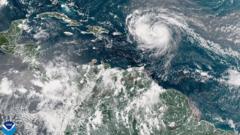Hurricane Erin has rapidly intensified into a category five hurricane, boasting maximum sustained winds of 160mph (260km/h). According to National Hurricane Center Director Mike Brennan, the storm underwent "explosive deepening" following its emergence from tropical storm strength on Friday. This powerful hurricane is expected to sweep past the Leeward Islands, Virgin Islands, and Puerto Rico throughout the weekend, potentially bringing as much as 6 inches (15 cm) of rain with threats of flash flooding and mudslides. Currently, Erin is not projected to hit the mainland US.
The phenomenon known as rapid intensification, wherein a storm strengthens by at least 34mph within a 24-hour span, was evident as Erin's winds surged from 100mph early Saturday morning to 160mph. Looking ahead, forecasts predict that Hurricane Erin will move gradually northward, skirting the eastern Bahamas and advancing towards North Carolina's Outer Banks.
The storm is set to generate dangerous surf and rip currents along almost the entire east coast of the United States next week, particularly endangering those in Florida and mid-Atlantic states. Bermuda may also experience hazardous surf conditions coupled with heavy rainfall. Due to gale-force winds, the US Coast Guard has mandated restrictions for vessels at ports in St. Thomas and St. John in the US Virgin Islands, as well as in six municipalities of Puerto Rico, including San Juan.
The National Oceanic and Atmospheric Administration (NOAA) has forecasted an "above normal" Atlantic hurricane season for 2025, attributing the anticipated rise in category four and five storms to global warming trends.


















